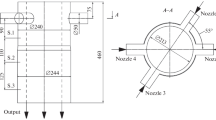Abstract
Experiments with impulse gas injection into model coolants, such as water or the Rose alloy, performed at the Novosibirsk Branch of the Nuclear Safety Institute, Russian Academy of Sciences, are described. The test facility and the experimental conditions are presented in details. The dependence of coolant pressure on the injected gas flow and the time of injection was determined. The purpose of these experiments was to verify the physical models of thermohydraulic codes for calculation of the processes that could occur during the rupture of tubes of a steam generator with heavy liquid metal coolant or during fuel rod failure in water-cooled reactors. The experimental results were used for verification of the HYDRA-IBRAE/LM system thermohydraulic code developed at the Nuclear Safety Institute, Russian Academy of Sciences. The models of gas bubble transportation in a vertical channel that are used in the code are described in detail. A two-phase flow pattern diagram and correlations for prediction of friction of bubbles and slugs as they float up in a vertical channel and of two-phase flow friction factor are presented. Based on the results of simulation of these experiments using the HYDRA-IBRAE/LM code, the arithmetic mean error in predicted pressures was calculated, and the predictions were analyzed considering the uncertainty in the input data, geometry of the test facility, and the error of the empirical correlation. The analysis revealed major factors having a considerable effect on the predictions. The recommendations are given on updating of the experimental results and improvement of the models used in the thermohydraulic code.
Similar content being viewed by others
References
V. M. Alipchenkov, A. M. Anfimov, D. A. Afremov, V. S. Gorbunov, Yu. A. Zeigarnik, A. V. Kudryavtsev, S. L. Osipov, N. A. Mosunova, V. F. Strizhov, and E. V. Usov, “Fundamentals, current state of the development of, and prospects for further improvement of the new-generation thermal-hydraulic computational HYDRA-IBRAE/LM code for simulation of fast reactor systems,” Therm. Eng. 63, 130–139 (2016). doi 10.1134/S0040601516020014
N. A. Radovcich and R. Moissis, The Transition from Two-Phase Bubble Flow to Slug Flow, MIT Report No. 7-7673-22 (MIT, Cambridge, MA, 1962).
P. Coste and S. Pigny, “Current status of thermohydraulic validation studies at CEA-Grenoble for the SIMMER-III code,” in Proc. IAEA Technical Committee Meeting on Methods and Codes for Calculations of Thermal Hydraulic Parameters for Fuel, Absorber Pins and Assemblies of LMFR’s with Traditional and Burner Cores, Obninsk, Russia, July 27–31, 1998 (Int. At. Energy Agency, Vienna, Austria, 2000), pp. 71–84.
G. B. Wallis, One-Dimensional Two-Phase Flows (McGraw-Hill, New York, 1969; Mir, Moscow, 1972).
J. R. Grace, “Shapes and velocities of bubbles rising in infinite liquids,” Trans. Inst. Chem. Eng. 51, 116–120 (1973).
J. R. Grace, T. Wairegi, and T. H. Nguyen, “Shapes and velocities of single drops and bubbles moving freely through immiscible liquids,” Trans. Inst. Chem. Eng. 54, 167–173 (1976).
R. Clift, and W. H. Gauvin, “Motion of entrained particles in gas streams,” Can. J. Chem. Eng. 49, 439–448 (1971).
A. Tomiyama, I. Kataoka, I. Zun, and T. Sakaguchi, “Drag coefficients of single bubbles under normal and micro gravity conditions,” JSME Int. J., Ser. B 41, 472–479 (1998).
E. Loth, “Quasi-steady shape and drag of deformable bubbles and drops,” Int. J. Multiphase Flow 34, 523–546 (2008).
D. A. Chisholm, “A theoretical basis for the Lockhart–Martinelli correlation for two-phase flow,” Int. J. Heat Mass Transfer 10, 1767–1778 (1967).
E. V. Usov, N. A. Pribaturin, I. G. Kudashov, A. A. Butov, G. A. Dugarov, N. A. Mosunova, V. F. Strizhov, and E. N. Ivanov, “A step in the verification of the HYDRA-IBRAE/LM/V1 thermohydraulic code for calculating sodium coolant flow in fuel-rod assemblies,” At. Energy 118, 382–388 (2015).
A. E. Vardy and J. M. Brown, “Transient turbulent friction in smooth pipe flows,” J. Sound Vib. 259, 1011–1036 (2003).
A. E. Vardy and J. M. Brown, “Transient, turbulent, smooth pipe friction,” J. Hydraul. Res. 33, 435–456 (1995).
A. V. Lykov, Theory of Heat Conduction (Vysshaya Shkola, Moscow, 1967) [in Russian].
F. W. Dittus and L. M. Boelter, “Heat transfer in automobile radiators of the tubular type,” Univ. Calif. Publ. Eng. 2, 443–461 (1930).
B. Lubarsky and S.J. Kaufman, Review of Experimental Investigations of Liquidmetal Heat Transfer, NASA Tech. Note 3336 (Natl. Advis. Comm. Aeronaut., Washington, DC, 1955).
Author information
Authors and Affiliations
Corresponding author
Additional information
Original Russian Text © P.D. Lobanov, E.V. Usov, A.A. Butov, N.A. Pribaturin, N.A. Mosunova, V.F. Strizhov, V.I. Chukhno, A.E. Kutlimetov, 2017, published in Teploenergetika.
Rights and permissions
About this article
Cite this article
Lobanov, P.D., Usov, E.V., Butov, A.A. et al. Experimental investigation of the impulse gas injection into liquid and the use of experimental data for verification of the HYDRA-IBRAE/LM thermohydraulic code. Therm. Eng. 64, 770–776 (2017). https://doi.org/10.1134/S004060151710007X
Received:
Accepted:
Published:
Issue Date:
DOI: https://doi.org/10.1134/S004060151710007X



